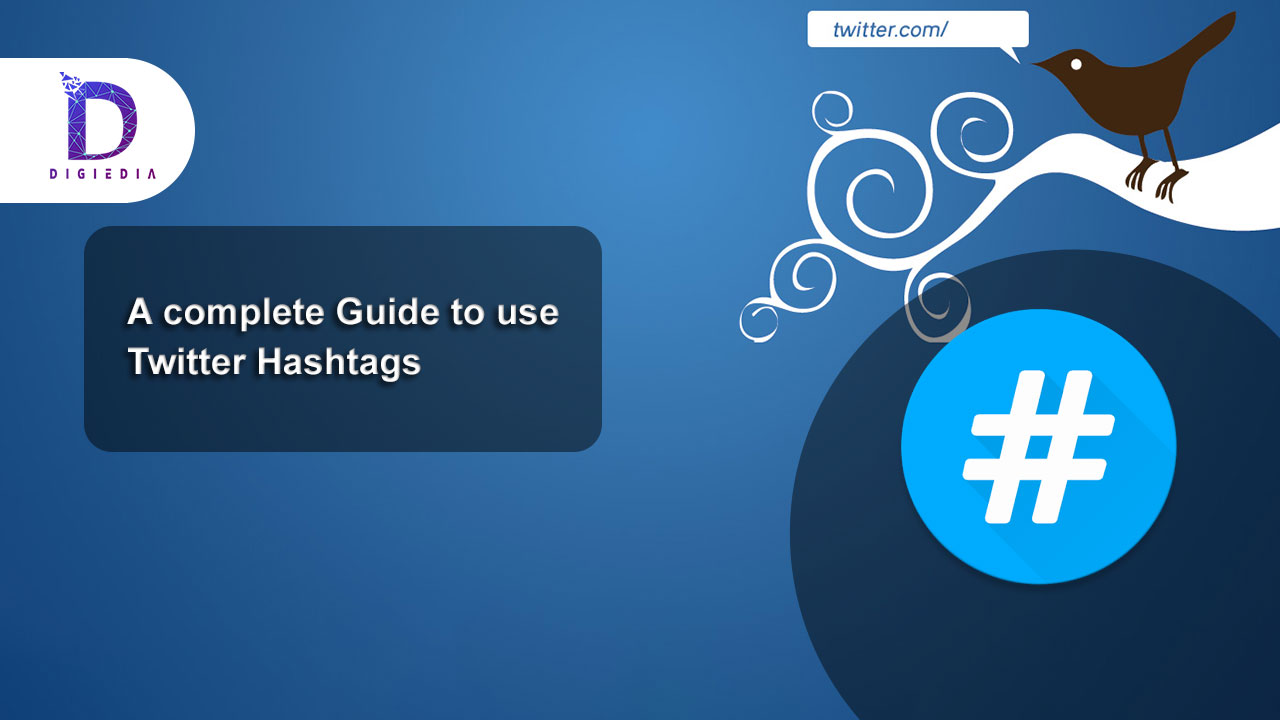
A guide to use Twitter Hashtags
- DIGIEDIA
- Blogs, Digital Marketing
- 17 January 2022
- No Comments
Before going through the guide to use Twitter Hashtags, let us understand what exactly are Hashtags and how to use them in general.
What exactly is a hashtag?
A hashtag is a string of words that is followed by the pound emblem.
It indicates (to users and algorithms) that a piece of information is connected to a particular topic or belongs to a category on social media.
Hashtags aid in the discovery of content in on-platform searches, allowing it to reach a larger audience. Before getting into the guide to use Twitter Hashtags, let us understand the fundamentals of using Hashtags.
Hashtag fundamentals
- They always begin with #, but they will not function if you use spaces, punctuation, or symbols.
- Make sure your reports are visible to the public. Otherwise, non-followers will not see the hashtagged substance you create.
- Don’t use too many words at once. The best hashtags are usually simple and quick to remember.
- Use hashtags that are relevant and specific. If it is too vague, it will be difficult to find and will not be being used by social media users.
- Use a limited number of hashtags. More isn’t always preferable. It appears to be spammy.
Guide to use Twitter Hashtags.
Why do we use hashtags?
Increase your followers’ engagement.
By including tags in your posts, you are participating in a conversation that is taking place on that social media platform. Above all, it makes your posts noticeable in that conversation. This can result in increased engagement, which can boost your brand’s social media engagement via likes, shares, comments, and new followers.
Using branded hashtags, you can increase brand awareness.
Creating a relevant hashtag can be a powerful way to encourage your company and spark conversations. For example, the Raptors’ branded hashtag #WetheNorth lit up during the team’s championship-winning season in 2019. It has broad appeal and was one of the most popular hashtags among Canadians in the first half of 2019.
Show your support for social causes.
Using a hashtag associated with an issue other than your brand is a great way to rally support for a worthy cause or issue.
On International Women’s Day, for example, the hashtags #EachforEqual and #IWD2020 were trending on social media platforms such as LinkedIn. Brands can also generate a branded hashtag that demonstrates their affiliation with a social issue.
Contextualize a social media post
You don’t have a lot of room to write a caption on Twitter. You have a total of 280 characters.
Longer captions on Instagram aren’t always the most effective. The same can be said for Facebook, Pinterest, LinkedIn, and any other platform—sometimes less is more.
Using a hashtag is a simple way to contextualize what you’re saying without taking up valuable character space or writing repetitive captions.
In July 2019, for example, NASA commemorated the 50th anniversary of the Apollo 11 moon landing. Its digital campaign included the use of the hashtag #Apollo50th. NASA posted one of the most popular tweets on World Emoji Day, which is also in July.
Make it easier for your target audience to find you.
Users who follow hashtags as well as many other users on Linkedin and Instagram. Another way to help new folks discover your brand is to use a few popular hashtags.
If you use the hashtag #travel in your Instagram posts, anyone who chooses to follow that hashtag will see your most recent post in their feed. You may gain some new supporters as a result of this.
Declare any sponsored partnerships.
This section is intended for brands and influencers that collaborate with influencers.
When collaborating with brands, influencers must inform their audiences that a piece of information is sponsored. It’s the law — in 2019, the FTC (Federal Trade Commissions) issued detailed marketing disclosure regulations for online influencers. Failure to comply can result in significant penalties for both the influencer and the brand. As a result, influencers should always include hashtags that clearly indicate a sponsorship in branded posts. When evaluating and accepting influencer content, brands should look for such hashtags.
When should I avoid using hashtags on Twitter?
If you want to drive traffic to your website, avoid using hashtags in your advertisements. Twitter discovered that ads without the need for a #hashtag or @mention generate 23% more clicks. Unsurprisingly, their best practice states: Avoid using #hashtags or @mentions in your copy to avoid having your audience click away from your ad.
Following is the continuation of the guide to use Twitter Hashtags.
How to Make Use of Hashtags on Twitter
Here are three hashtag guidelines to remember:
- You can include one or more hashtags in your tweet at any time. Twitter suggests using no or more than two hashtags per Tweet, but you can use as many as you want.
- In a hashtag, no spaces are allowed. ‘#World Cup,’ for example, would refer to the topic of ‘World,’ as opposed to ‘#WorldCup,’ which refers to the ‘World Cup.’
- In a hashtag, no punctuation is allowed. #It’sComingHome, for example, will not work, despite being grammatically correct. Instead, use the hashtag #ItsComingHome.
Creating a memorable hashtag is a great way to increase brand awareness, but keep in mind to follow these three steps.
- Check to see if it already exists – Conduct a full examination on Twitter to ensure that your newly proposed hashtag does not already exist or has not been used negatively in the past.
- Consider the length – a hashtag should be brief and memorable. Making a hashtag out of a long-phrase will not yield the desired results, and it will be more likely to be mistyped. Your message should be conveyed in three words or less.
- Use capital letters – Although Twitter hashtags are not case sensitive, capital letters make your hashtag more readable. #SocialMediaMarketing vs. #SocialMediaMarketing It also prevents hashtags from being misinterpreted.
Hashtags aren’t going away. You can’t afford to ignore them because they’re so useful for identifying topics. The above guide to use Twitter hashtags will help you use relevant hashtags on your customer’s tweets to achieve new audiences and increase brand awareness.
